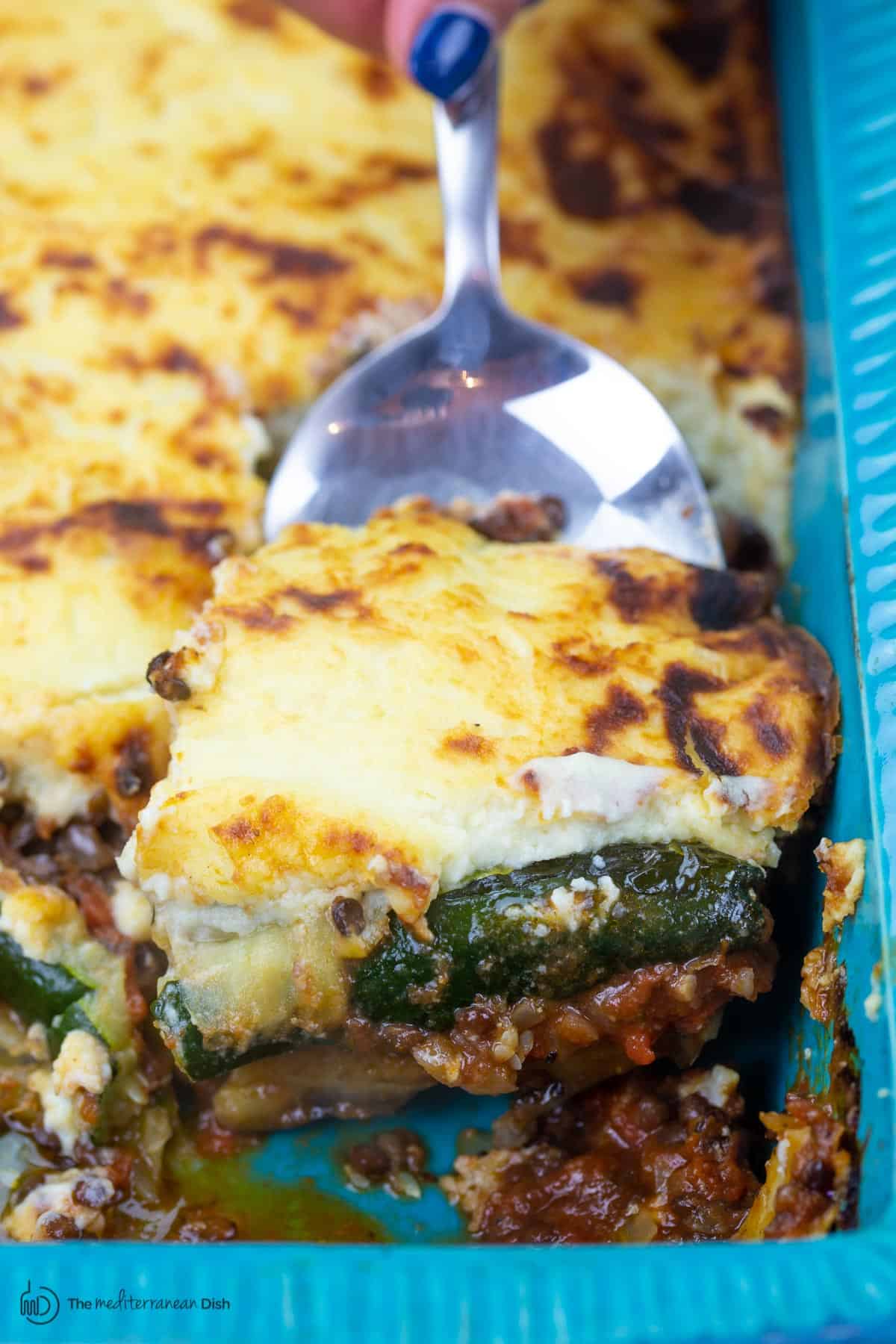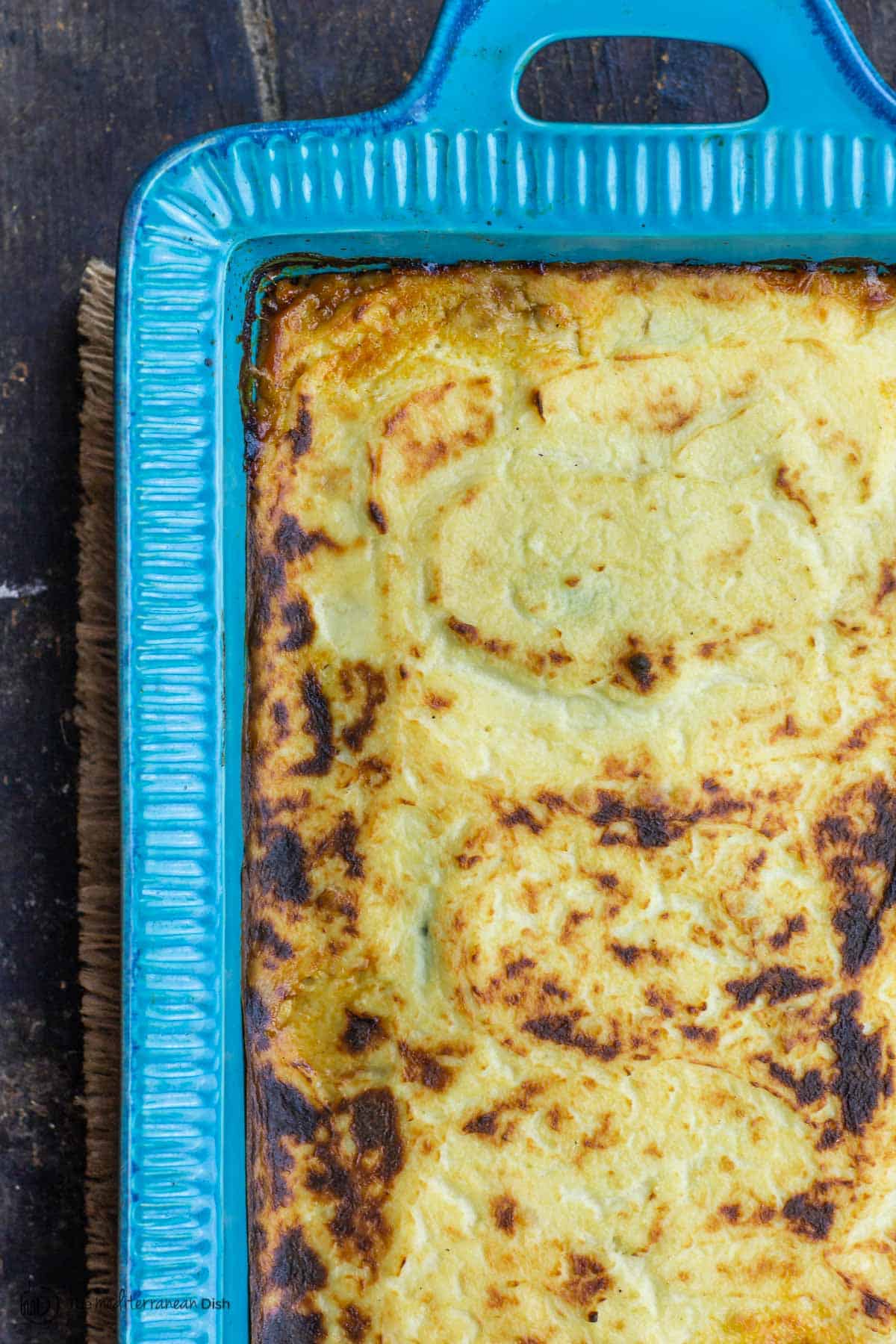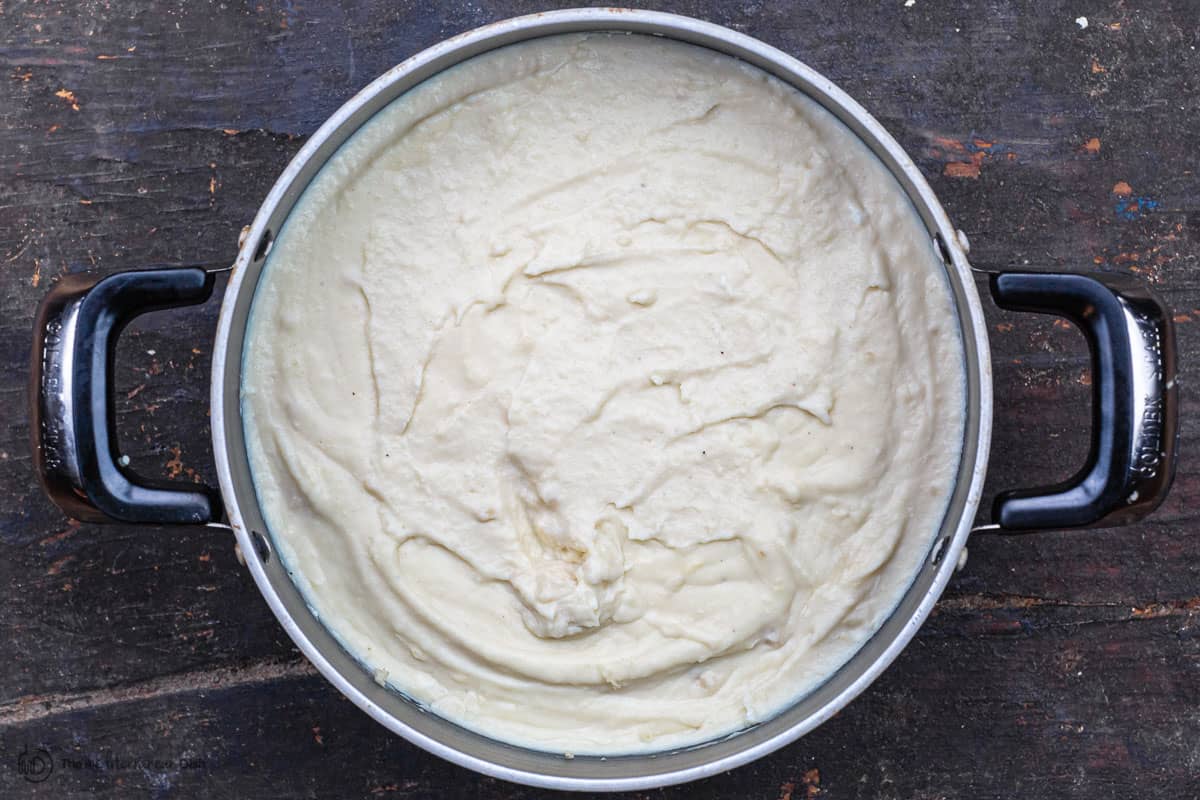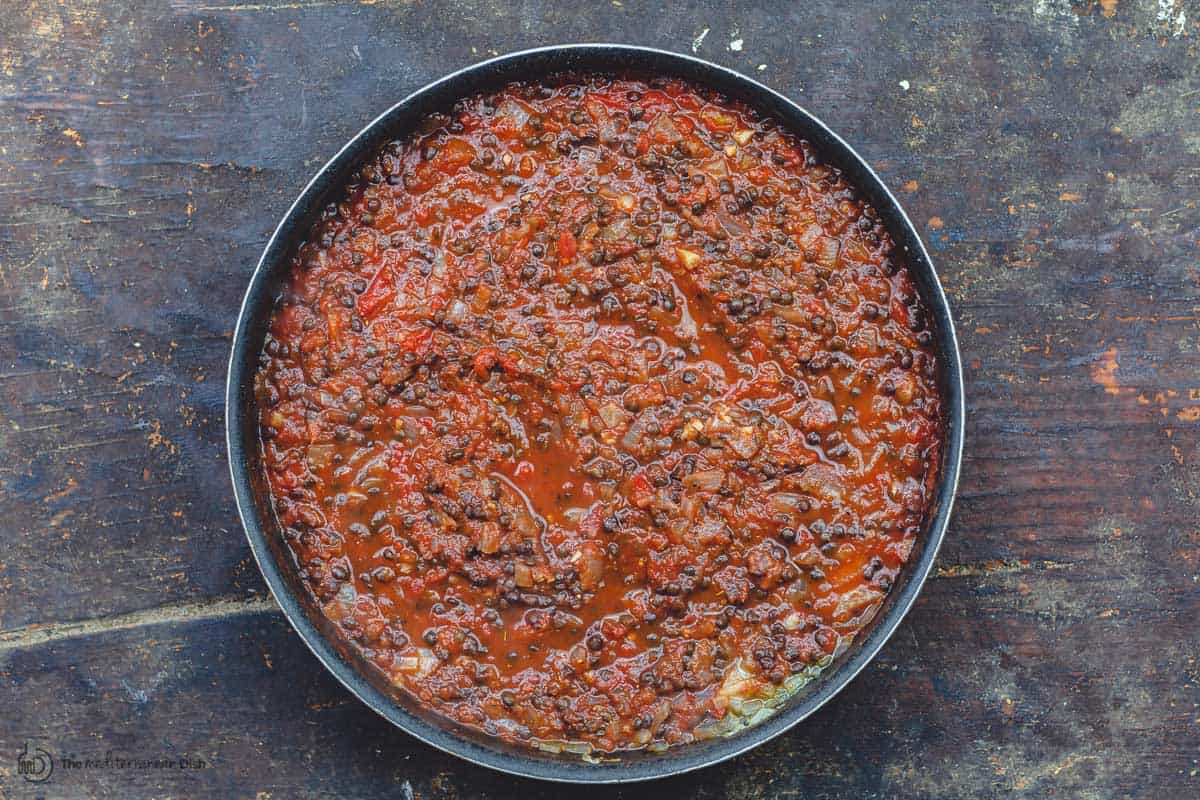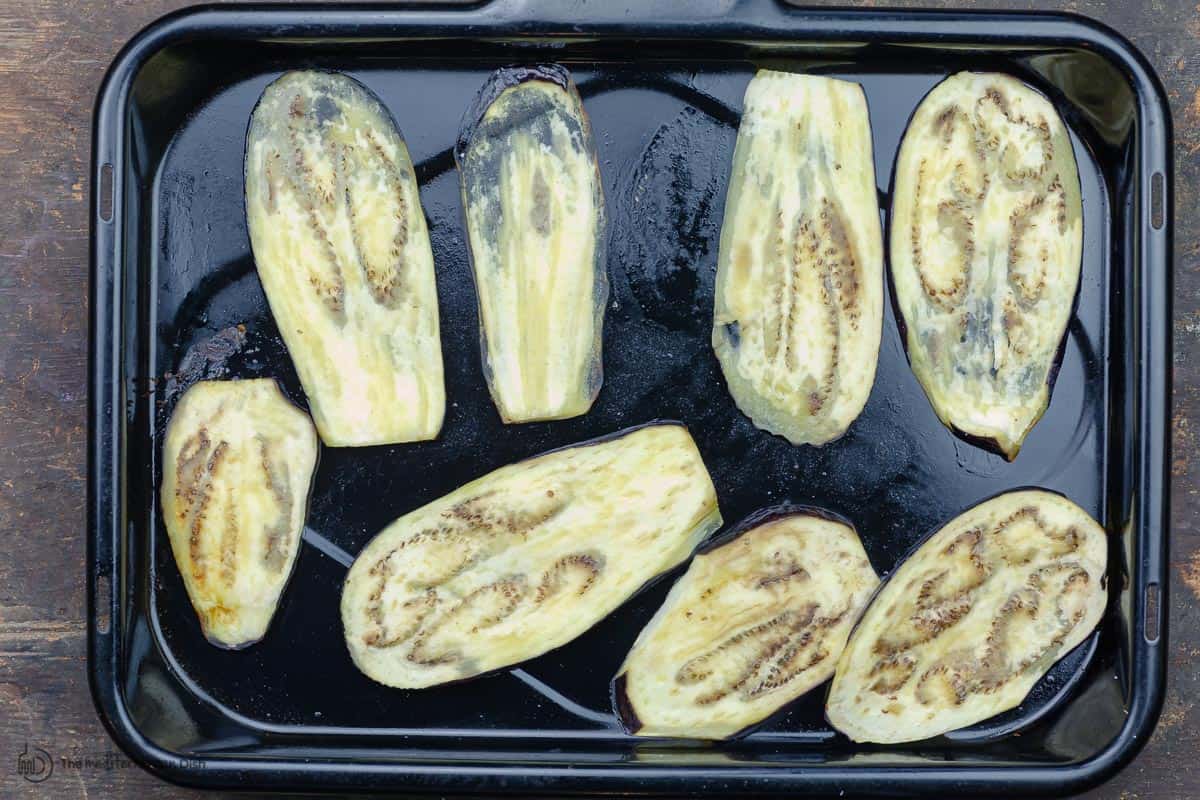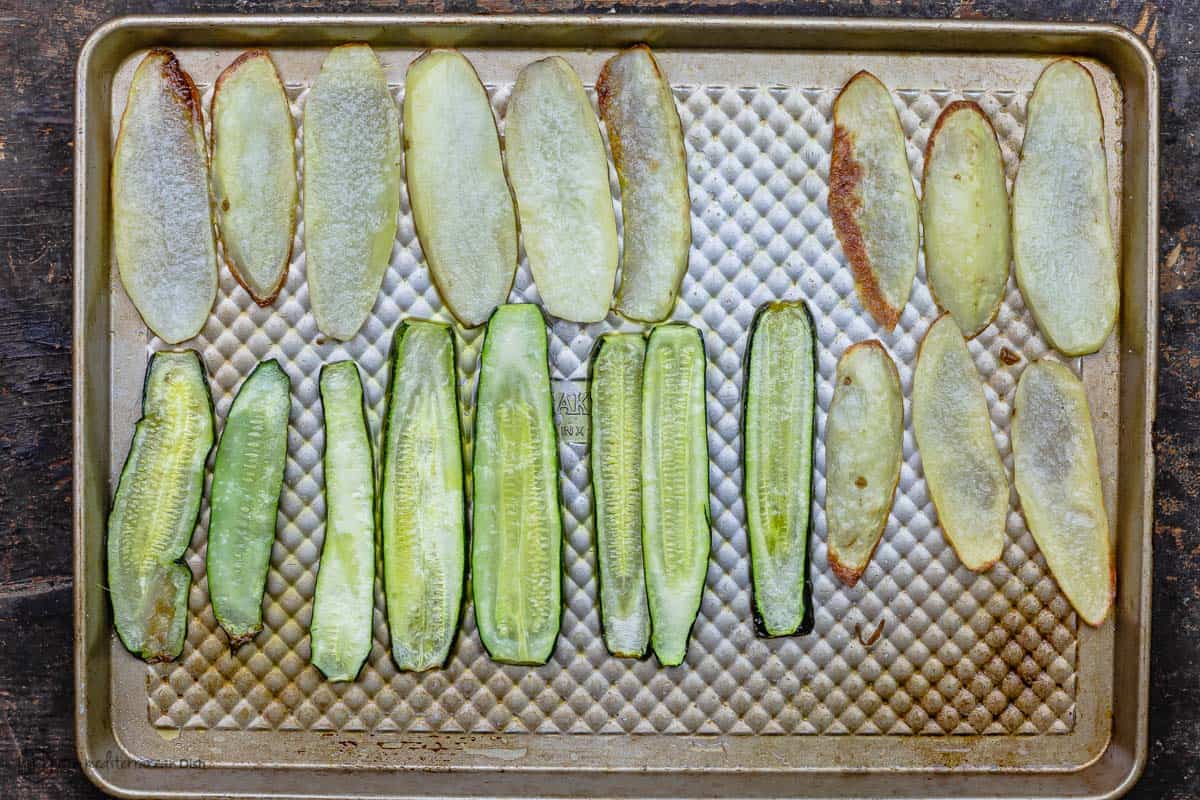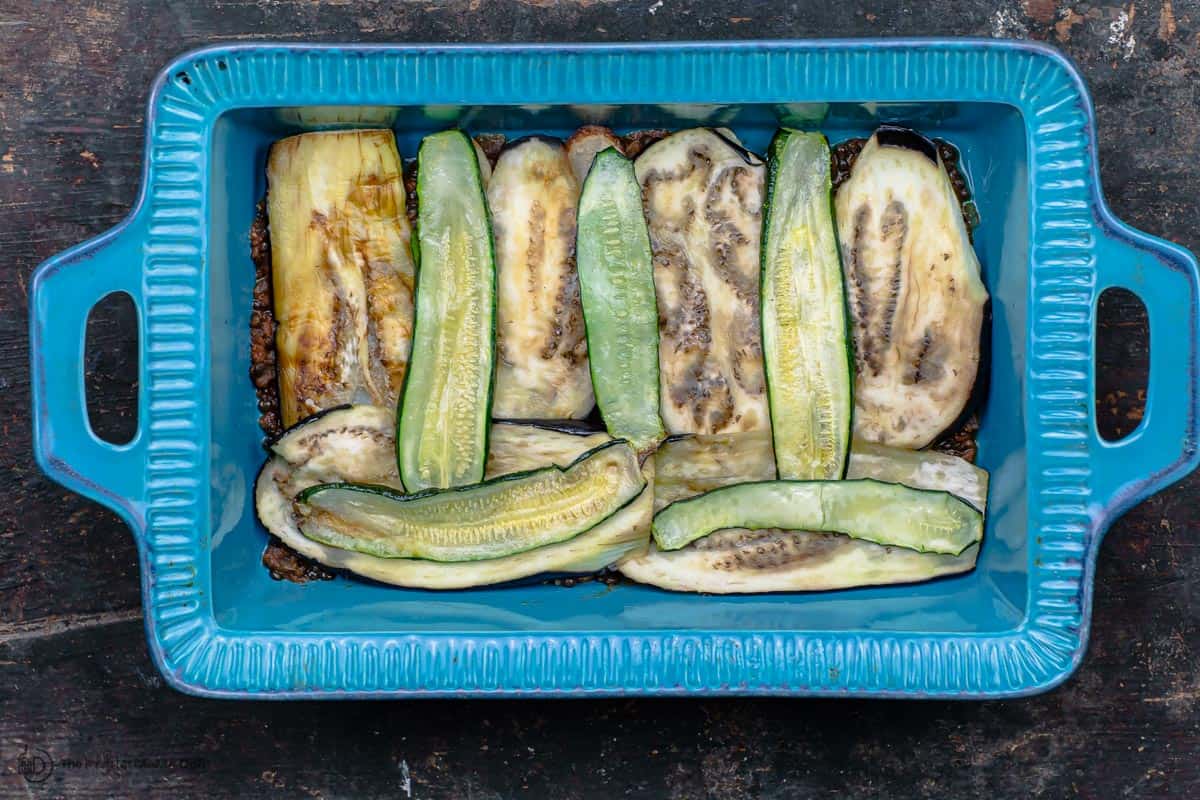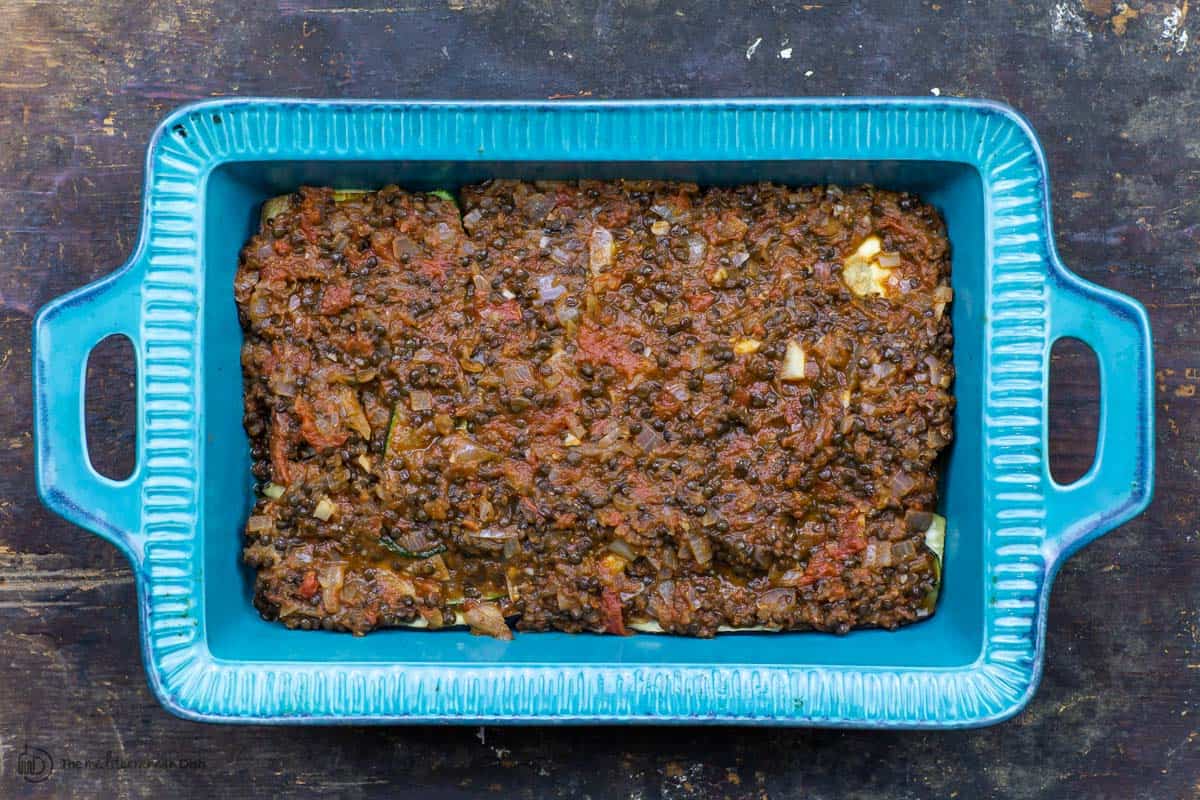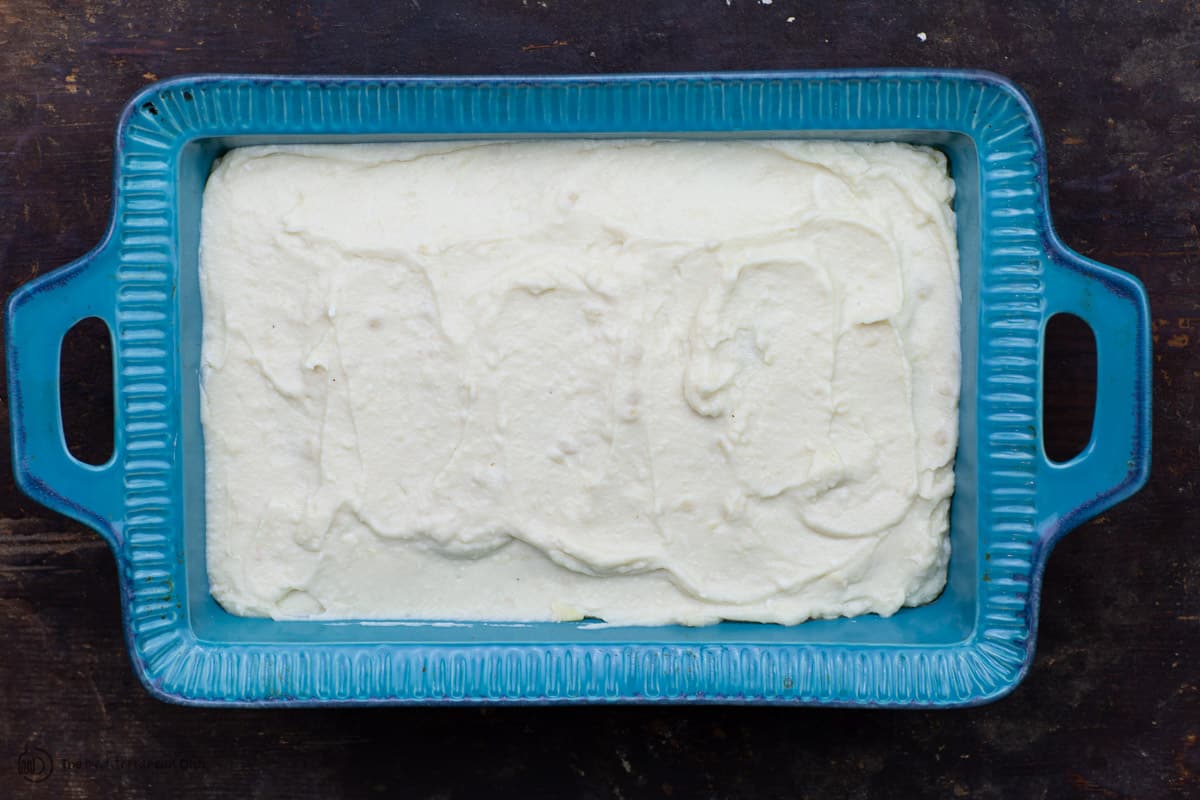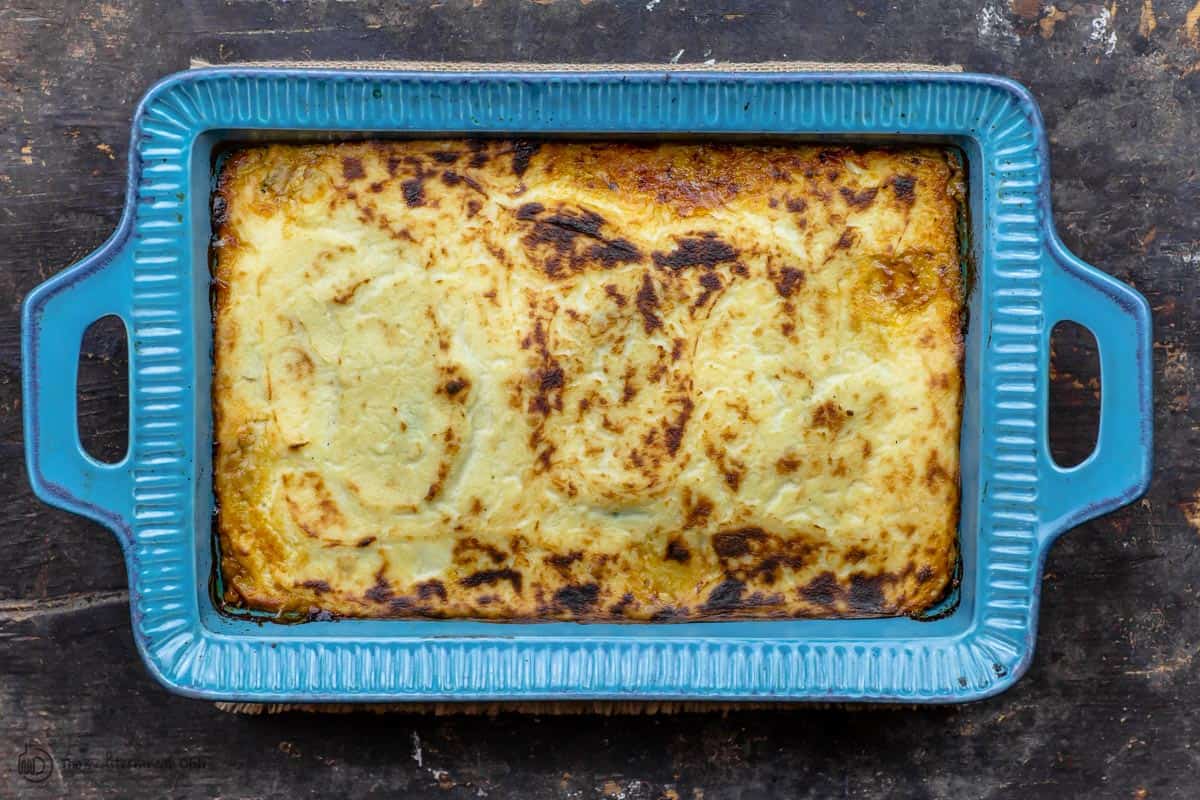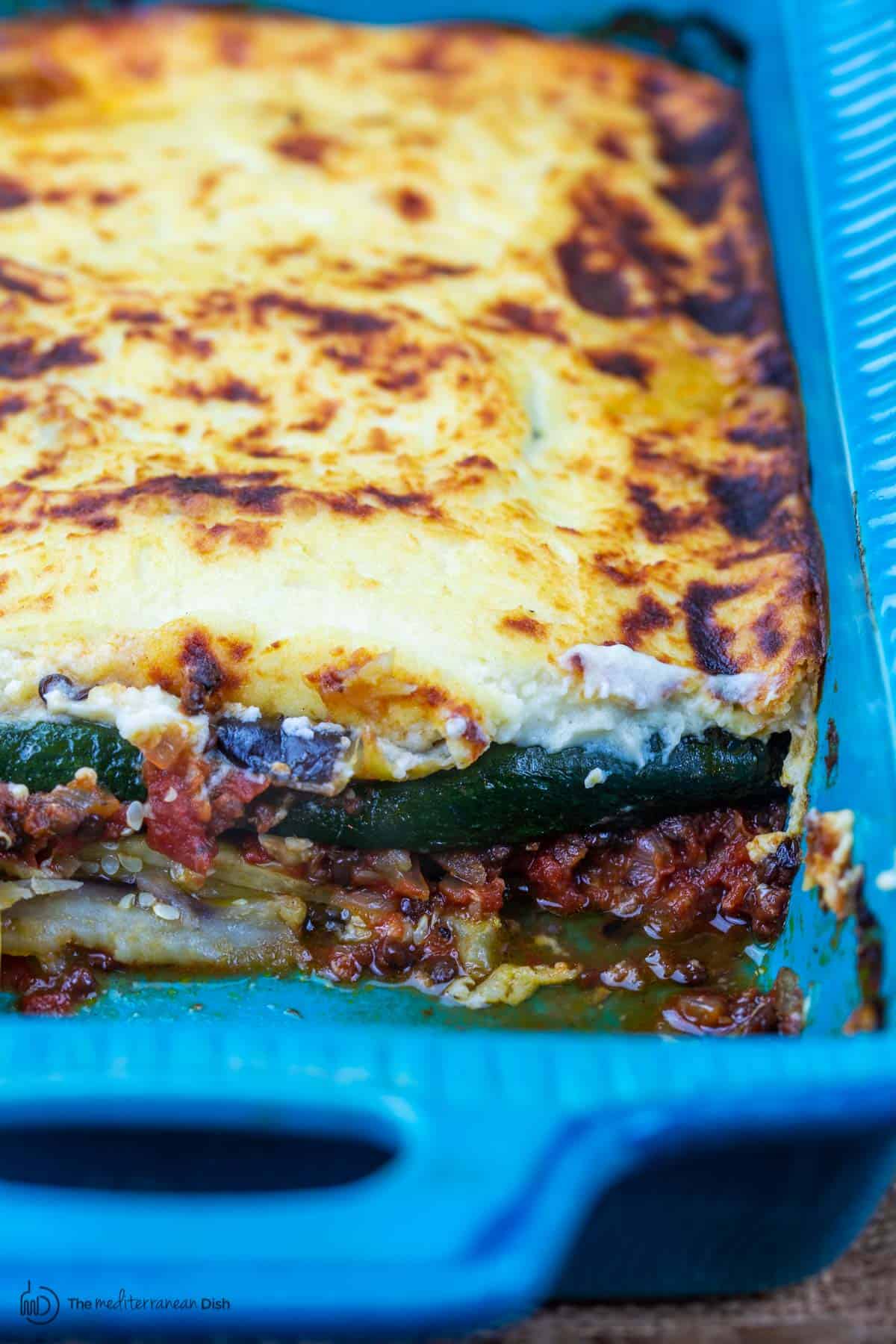This roasted vegetable moussaka is easier to put together than you think. Be sure to check out my step-by-step tutorial and grab my make-ahead tips below!
A little twist on traditional moussaka
We can all agree that moussaka is Greek comfort food at it’s finest! And, yes, the popular flavor-packed eggplant casserole, topped with creamy bechamel sauce, is a labor of love. There are typically several layers and a few steps involved. But if you’ve ever made it, you know that it’s totally worth the effort for a special family dinner. I shared my earlier Greek-style moussaka recipe and my Egyptian-style moussaka, both made with a juicy meat sauce. Since then, I have gotten many requests for a meatless version. I’ve been playing around with different ingredients, and I finally have the BEST vegetarian moussaka that is as scrumptious and tasty as my meat-lovers’ version. This vegetable moussaka casserole is made of layers of quick-roasted vegetables; a tasty rich tomato sauce with black lentils in place of ground meat; and creamy bechamel to top it all. Let’s dive more into this vegetarian eggplant moussaka, what’s in it, and how to make it!
Vegetable moussaka components
It helps to think of this vegetarian moussaka recipe as having three components: vegetables; a vegetarian sauce; and a top layer of creamy bechamel. To make the best vegetarian moussaka, it took some tinkering around with ingredients to make a version that felt just as hearty and unctuous as my earlier meaty beef (or lamb) version. To really knock this recipe out of the park, I had to find the PERFECT meat substitute that held up well in the sauce and provided a great hearty texture. The verdict? Black Beluga lentils. Black lentils are petite and cook fairly quickly. They have a wonderful, creamy consistency; full-bodied and earthy flavor. Not to mention, they’re a great source of protein, polyphenolas, iron, and fiber…(find black lentils here.) In this vegetarian moussaka, a scrumptious tomato-lentil sauce–with a fragrant pinch of nutmeg and cinnamon–is nestled between quick-roasted vegetables, including tender eggplant. And of course to top our eggplant casserole is none other than creamy bechamel sauce!
What vegetables go in vegetarian moussaka? And what else do you need to make it?
The components of this vegetarian moussaka recipe are not hard to make. There are three components as I mentioned earlier: vegetables, sauce, and a top layer of bechamel. Let’s walk through them some more:
1. Roasted Vegetables
For this vegetarian eggplant moussaka recipe, eggplant remains the star. I also add 2 to 3 russet potatoes and 2 zucchini. All the veggies are sliced the long way to create our different layers. Eggplant needs a little extra TLC. So we start with giving our eggplant slices a sprinkle of kosher salt and leave it alone for 20 to 30 minutes to “sweat out” any bitterness. To prepare the vegetables for our vegetarian moussaka, we give them a quick roast in hot oven for 15 to 20 minutes.
2. Tomato-Lentil Sauce
This lentil sauce is my vegetarian replacement for meat sauce. It incorporates cooked black bluga lentils with crushed tomatoes and aromatics like minced garlic, onions, a pinch of nutmeg and cinnamon. After a brief simmer, this sauce is hearty and creamy, you won’t miss the meat.
3. Bechamel
We’re not taking shortcuts here with this roasted vegetable moussaka. The very top layer of creamy bechamel is essential, making this dish as scrumptious and comforting as they come! Although bechamel sounds scary and intimidating, it is fairly easy to make (we’ve done it before in this pastitsio recipe.) Essentially, you make a roux with flour and quality extra virgin olive oil (some use butter, but I prefer olive oil here.) Let it brown a tad, add in warm milk (bit-by-bit), whisk, season, and add in tempered eggs, while continuing to whisk a little bit more until nice and smooth. Let’s get to the step-by-step…
How to Make this Vegetarian Moussaka – Step-by-Step
In a small bowl, whisk a small amount of the hot bechamel mixture with the 2 eggs. Then return all to the pan with the remaining bechamel mixture. Continue to stir or whisk the mixture bringing to a gentle boil for just 2 more minutes. Taste and adjust salt and pepper. Remove from heat and allow to cool and thicken a little more (you should have a creamy, thick and smooth bechamel sauce). Tip: if your olive oil and flour mixture is too dry and looks chunky, drizzle in a little more olive oil until it looks like a smooth paste.
Prepare the tomato-lentil sauce. First, saute the onions and garlic briefly until they smell delicious. Add your already COOKED black lentils, tomatoes, and broth. Season and add spices. Let it come to a boil and then over part way with a lid, turn the heat down, and simmer for 15-20 minutes. How to cook black lentils for this sauce? To cook the black lentils first before you add them to sauce, begin with 1/2 cup dry black lentils. Add 1 1/2 cups water. Bring to a boil, then cover and reduce heat to medium-low. Simmer until lentils are tender (about 20 to 25 minutes, adding more water as needed to keep the lentils submerged.) Drain.
Roast the Vegetables. While the lentil sauce is simmering, take your dry eggplant and place it with the potatoes and zucchini on lightly-oiled baking sheets (you’ll need more than one baking sheet to spread the veggies in one layer.) Sprinkle the zucchini and potatoes with salt (eggplant is already salted.) Give the veggies a brush of extra virgin olive oil. Roast in heated oven for 15 to 20 minutes.
Assemble to moussaka. You have made it, time to put it all together! Ladle a little bit of the lentil sauce on the bottom of a lightly oiled casserole pan. Layer the roasted veggies on top…
Now add the rest of the tomato lentil sauce…
Add bechamel on top. Be sure to spread the bechamel and smooth it out with the back of a spoon.
- Bake! The vegetarian moussaka casserole can take somewhere between 45 minutes to 1 hour in your heated oven. You’re looking for the top bechamel layer to turn a nice golden brown (if needed, place it under the broiler for a tiny bit, watching very closely to make sure you get the color you want.)
Can you eat eggplant skin?
Many people think eating eggplant skin is a no-no, but the exact opposite is true. When eggplant is cooked, the skin becomes tender and soft and is great to eat. It packs lots of vitamins, minerals, and fiber. (If you need to, you can partially peel the eggplant leaving just some of the skin on.)
Why do you salt eggplant?
The first step I take whenever I work with eggplant, whether to fry or roast it, is salting it. This is important for two reasons: First, it allows a lot of the moisture in the eggplant to release. If you cook eggplant without salting and patting dry with paper towels, your moussaka can get watery and make your dish soggy and less flavorful. Nobody wants that! Second, eggplant tends to be a little bitter and the salt counteracts that bitterness. You are left with a much sweet and milder slice of eggplant after salting. To save time in this recipe, as you saw in the step-by-step above, I start by salting the eggplant then move on to working on the bechamel etc. if you are going to make moussaka, do it right!
Can this vegetable moussaka be prepared ahead?
Despite the number of steps involved, this vegetarian moussaka is not too complicated to prepare. And, even better, you can prepare parts of this recipe ahead of time. You have a couple of options… You can cut and roast all your veggies, make the tomato lentil sauce, and even prepare the bechamel 1 night in advance (I’ve done it 2 nights in advance as well, but since there may be leftovers, I try not to work too far ahead.) You can store the different components in separate containers in the fridge, and when you are ready, assemble and bake! If you decide to make the bechamel in advance, you will need to warm it up in pot before you can pour it on the top of your moussaka. As it sits in the fridge, it will get very thick and slightly gelatinous. You may need to add an extra splash of milk to thin the sauce out and get it back to its pourable consistency. If you don’t want to worry about this, just make the bechamel right before you are going to assemble. That way it’s fresh and requires no extra steps.
Leftovers
You’re likely to have leftovers, which is great because it tastes just as good the next day. You can place them in an airtight container for about 3 days.
Can you freeze vegetarian moussaka?
If you need to freeze your leftovers, it is a perfect solution for making the vegetarian moussaka last longer. It will keep well for up to 1 month in the freezer. Plus, no thawing needed, it can be baked right away from freezer to oven!
What do you serve with this eggplant casserole?
This type of eggplant casserole is a full meal in and of itself. But if you are looking for a little something extra, add a big Greek salad or simple Shirazi salad to start. Still want some meat? Server a few Keftedes or a couple skewers of souvlaki along. You may also like: Eggplant Lasagna Eggplant Rollatini Caponata Baked Zucchini For all recipes, visit us here. And be sure to view our collection of Mediterranean diet recipes. NEVER MISS A RECIPE! JOIN MY FREE E-MAIL LIST HERE. SHOP OUR ONLINE STORE FOR QUALITY OLIVE OILS, ALL-NATURAL SPICES AND MORE. 4.7 from 80 reviews This roasted vegetable moussaka is easier to put together than you think. Be sure to check out my step-by-step tutorial and grab my make-ahead tips.
1/3 cup + 2 tbsp Private Reserve Greek extra virgin olive oil 2/3 cup all-purpose flour 1/2 tsp salt, more if you like 1/4 tsp ground nutmeg 4 cups 2% milk, warmed 2 large eggs
For Lentil Sauce:
1 yellow onion, chopped 2 garlic cloves, minced 1 ¼ cup COOKED black lentils (from ½ cup uncooked black lentils. See notes) 1 14-oz can crushed tomatoes ½ cup broth or water 1 tsp dry oregano ½ tsp nutmeg Pinch cinnamon

